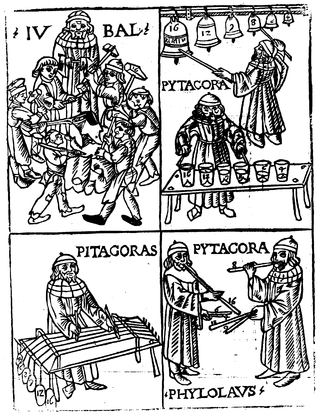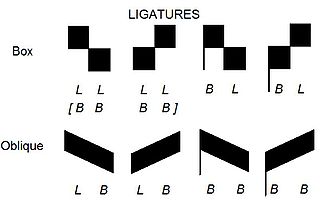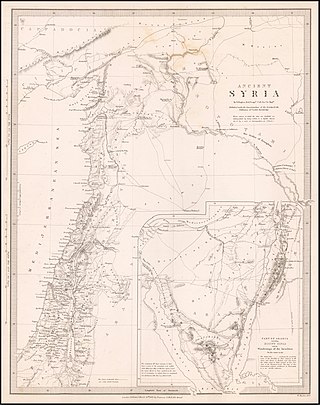External links
- Neume Notation Project. Louis W. G. Barton.
- Chironomy in the Ancient World [usurped]
Cheironomy or chironomy is a form of music conducting, typically with choral music and choral groups (choirs), where the use of hand gestures directs musical performance. In the modern artform, conductors tend to hoist batons for indicating melodic curves and ornaments.
Early music (vocal church music), as far back as the 5th century, required some central direction from a leader in the coordination of singers in their delivery of melodic lines of mostly free rhythm. Traced back to early Egyptian performances through hieroglyphic documentation (etchings in stone depicting a leader employing hand signals to indicate pitch and rhythm details for wind instrument players)[ citation needed ], this form of conducting seems to predate Guido of Arezzo's designation of joints of the fingers for indicating pitches, and seems to have offered more than limited pitch instruction. These early leaders, or cheironomers, though possessing none of the modern conducting skills developed in the 17th century, using a form of choreographed hand signals, adeptly controlled the movement of the melodic lines, producing incredibly well-synchronized performances.
Cheironomy, though not a commonly used term in today's reference to conducting, serves, as it did in early music, as the model for the motions necessary to direct some modern music which requires individualized direction to specific players, within less metrically structured musical compositions. It is still in use in the liturgy of the Roman Catholic Church (despite a decline of chant in the late twentieth century), of some Middle Eastern sects and in synagogues to direct the singing of liturgical songs (Hebrews probably learned cheironomy from Egyptians), and, more rarely, in some ancient Western religions.
The New Grove Dictionary of Music and Musicians comments that the method is particularly developed in traditions lacking a written notation, including Vedic, Byzantine and Roman chants.
Jewish religious cheironomy can also be found as mnemonic signs in printed Hebrew Bibles, appearing above, below and amidst the text to be sung, to guide the cantor in his rendition of Biblical readings: see Cantillation .

Music is the arrangement of sound to create some combination of form, harmony, melody, rhythm, or otherwise expressive content. Music is generally agreed to be a cultural universal that is present in all human societies. Definitions of music vary widely in substance and approach. While scholars agree that music is defined by a small number of specific elements, there is no consensus as to what these necessary elements are. Music is often characterized as a highly versatile medium for expressing human creativity. Diverse activities are involved in the creation of music, and are often divided into categories of composition, improvisation, and performance. Music may be performed using a wide variety of musical instruments, including the human voice. It can also be composed, sequenced, or otherwise produced to be indirectly played mechanically or electronically, such as via a music box, barrel organ, or digital audio workstation software on a computer.

Medieval music encompasses the sacred and secular music of Western Europe during the Middle Ages, from approximately the 6th to 15th centuries. It is the first and longest major era of Western classical music and is followed by the Renaissance music; the two eras comprise what musicologists generally term as early music, preceding the common practice period. Following the traditional division of the Middle Ages, medieval music can be divided into Early (500–1000), High (1000–1300), and Late (1300–1400) medieval music.

Musical notation is any system used to visually represent music. Systems of notation generally represent the elements of a piece of music that are considered important for its performance in the context of a given musical tradition. The process of interpreting musical notation is often referred to as reading music.
Semiology is a branch of Gregorian Chant research. Semiology refers specifically to the study of the neumes as found in the earliest fully notated manuscripts of Gregorian Chant, the oldest of which have been dated to the 9th century. The first application of the term 'semiology' for the study of Latin chant was made by Dom Eugène Cardine (1905–1988), a monk of the Abbey of Solesmes. In this context, 'semiology' is understood as 'the study of musical signs'. Text and neumatic notation, together with significative letters adjoined to the neumes, presents an effective and integrated mnemonic for the rhythmical interpretation and the melody. While Gregorian palaeography offers a description of the various neumes and their rhythmical and melodic values, Gregorian semiology explains their meaning for practical interpretation.

Music theory is the study of theoretical frameworks for understanding the practices and possibilities of music. The Oxford Companion to Music describes three interrelated uses of the term "music theory": The first is the "rudiments", that are needed to understand music notation ; the second is learning scholars' views on music from antiquity to the present; the third is a sub-topic of musicology that "seeks to define processes and general principles in music". The musicological approach to theory differs from music analysis "in that it takes as its starting-point not the individual work or performance but the fundamental materials from which it is built."
Plainsong or plainchant is a body of chants used in the liturgies of the Western Church. When referring to the term plainsong, it is those sacred pieces that are composed in Latin text. Plainsong was the exclusive form of the Western Christian church music until the ninth century, and the introduction of polyphony.
Sheet music is a handwritten or printed form of musical notation that uses musical symbols to indicate the pitches, rhythms, or chords of a song or instrumental musical piece. Like its analogs – printed books or pamphlets in English, Arabic, or other languages – the medium of sheet music typically is paper. However, access to musical notation since the 1980s has included the presentation of musical notation on computer screens and the development of scorewriter computer programs that can notate a song or piece electronically, and, in some cases, "play back" the notated music using a synthesizer or virtual instruments.
Articles related to music include:

Gregorian chant is the central tradition of Western plainchant, a form of monophonic, unaccompanied sacred song in Latin of the Roman Catholic Church. Gregorian chant developed mainly in western and central Europe during the 9th and 10th centuries, with later additions and redactions. Although popular legend credits Pope Gregory I with inventing Gregorian chant, scholars believe that it arose from a later Carolingian synthesis of the Old Roman chant and Gallican chant.

Conducting is the art of directing a musical performance, such as an orchestral or choral concert. It has been defined as "the art of directing the simultaneous performance of several players or singers by the use of gesture." The primary duties of the conductor are to interpret the score in a way that reflects the specific indications in that score, set the tempo, ensure correct entries by ensemble members, and "shape" the phrasing where appropriate. Conductors communicate with their musicians primarily through hand gestures, usually with the aid of a baton, and may use other gestures or signals such as facial expression and eye contact. A conductor usually supplements their direction with verbal instructions to their musicians in rehearsal.

In music notation, a ligature is a graphic symbol that tells a musician to perform two or more notes in a single gesture, and on a single syllable. It was primarily used from around 800 to 1650 AD. Ligatures are characteristic of neumatic (chant) and mensural notation. The notation and meaning of ligatures has changed significantly throughout Western music history, and their precise interpretation is a continuing subject of debate among musicologists.

A neume is the basic element of Western and some Eastern systems of musical notation prior to the invention of five-line staff notation.

Little is known about Hungarian music prior to the 11th century, when the first Kings of Hungary were Christianized and Gregorian chant was introduced. During this period a bishop from Venice wrote the first surviving remark about Hungarian folk song when he commented on the peculiar singing style of a maid. Church schools in Hungary taught Western Christian chanting, especially in places like Esztergom, Nyitra, Nagyvárad, Pannonhalma, Veszprém, Vác and Csanád; and later schools began focusing on singing, spreading Latin hymns across the country.

Syrian chant is one of the oldest Christian chants in the world. Due to the lack of information concerning early musical manuscripts, it is conjectural to what extent the modern repertoire reflects the early traditions. What we know of the sound in Syrian chant is mainly derived from modern performances. Modern performances have a sparse texture and are highly ornamented. The setting within which Syriac chant takes place is, also only understood through the modern performances of Syriac chant. The chant seems to be designed to resonate throughout the building it is performed in. This suggests that the setting was always a church building or a room that reflected the sound of the walls and ceilings. There is some difficulty in studying Syrian chant due to the geopolitical conflict throughout Syrian Christian history. Many of the conflicts have resulted in persecution of Syrian Christians which may account for the oral tradition of Syriac chant. The history of Syriac chant is derived from diaspora and persecution.
A baton is a stick that is used by conductors primarily to enlarge and enhance the manual and bodily movements associated with directing an ensemble of musicians.
In medieval music theory, the Latin term modus can be used in a variety of distinct senses. The most commonly used meaning today relates to the organisation of pitch in scales. Other meanings refer to the notation of rhythms.

Knowledge of the biblical period is mostly from literary references in the Bible and post-biblical sources. Religion and music historian Herbert Lockyer, Jr. writes that "music, both vocal and instrumental, was well cultivated among the Hebrews, the New Testament Christians, and the Christian church through the centuries." He adds that "a look at the Old Testament reveals how God's ancient people were devoted to the study and practice of music, which holds a unique place in the historical and prophetic books, as well as the Psalter."
Prostopinije is a type of monodic church chant, closely related to other East Slavic chants such as Galician Samoilka, Kievan Chant and Znamenny chant. Prostopinije is used in the Ruthenian Greek Catholic Church, Slovak Greek Catholic Church, Hungarian Greek Catholic Church, and by the Carpatho-Russian Orthodox.

Music technology is the study or the use of any device, mechanism, machine or tool by a musician or composer to make or perform music; to compose, notate, playback or record songs or pieces; or to analyze or edit music.

Mechanical music technology is the use of any device, mechanism, machine or tool by a musician or composer to make or perform music; to compose, notate, play back or record songs or pieces; or to analyze or edit music. The earliest known applications of technology to music was prehistoric peoples' use of a tool to hand-drill holes in bones to make simple flutes. Ancient Egyptians developed stringed instruments, such as harps, lyres and lutes, which required making thin strings and some type of peg system for adjusting the pitch of the strings. Ancient Egyptians also used wind instruments such as double clarinets and percussion instruments such as cymbals. In Ancient Greece, instruments included the double-reed aulos and the lyre. Numerous instruments are referred to in the Bible, including the horn, pipe, lyre, harp, and bagpipe. During Biblical times, the cornet, flute, horn, organ, pipe, and trumpet were also used. During the Middle Ages, hand-written music notation was developed to write down the notes of religious Plainchant melodies; this notation enabled the Catholic church to disseminate the same chant melodies across its entire empire.